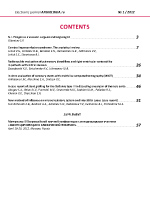Electronic journal ANGIOLOGIA.ru
№ 1 / 2012
N.I. Pirogov as a vascular surgeon and angiologist
Gliantcev S.P.
The article covers N.I. Pirogov’s contribution to the development of vascular surgery and angiology.
Cerebral hyperperfusion syndrome. The analytical review
Leliuk V.G., Kerbikov O.B., Borskaia E.N., Ramazanov G.R., Akhmetov V.V., Leliuk S.E., Skvortcova B.I.
Cerebral hyperperfusion syndrome (CHS) is one of the serious complications of carotid revascularization either after carotid endarterectomy (CEA) or carotid artery stenting (CAS). The mean incidence of CHS post CAS is 1.16% (ranges from 0.44% to 11.7%), and post CEA – 1.9% (ranges from 0.4% to 14.0%). CHS is characterized by the clinical triad including ipsilateral migraine-like headache, focal neurological deficit and seizures as well as ipsilateral intracerebral hemorrhage (the most devastating complication of CHS after revascularization) in combination with the relative or absolute hyperperfusion. Hyperperfusion is defined as an increase in ipsilateral cerebral blood flow, of ≥100% compared with preoperative or baseline values. CHS can develop at any time from immediately after surgery to up to several weeks after revascularization. But in the majority of cases, CHS develops within 12-24 hours after stenting or in 5-7 days after CEA. Several interlinked and synergetic mechanisms play the leading role in the CHS pathogenesis. The most important of them include the impairment of cerebral blood flow autoregulation due to prolonged hypoperfusion in the territory of the affected vessel and high blood pressure in intra- and/or postoperative periods. The most common methods for diagnosing CHS are transcranial Doppler (TCD) and single photon emission computed tomography (SPECT) and also perfusion-weighted CT, MRI and PET. The known risk factors for the development and progression of CHS are prolonged arterial hypertension, age >72 years, diabetes mellitus, high-grade ipsi- and contralateral stenosis, reduced cerebrovascular reactivity etc. However, all the above-mentioned factors do not make it possible to determine which patients have a high risk of developing CHS. The main prevention method for CHS is aggressive management of blood pressure in pre-, intra- and postoperative periods. Some other techniques have also been proposed such as "successive procedures of stenting" in patients at high risk of CHS. The management of patients with CHS is focused on reducing clinical symptoms and preventing their progression. It is based on the intensive blood pressure control, treatment of cerebral edema and anticonvulsant therapy. The prognosis depends on timeliness of diagnosis and adequate treatment. The majority of patients who have been diagnosed and treated early recover completely, while in neglected cases disability and mortality risks are high.
Radionuclide evaluation of pulmonary blood flow and right ventricular contractility in patients with mitral stenosis
Zavadovskii K.V., Evtushenko A.V., Lishmanov IU.B.
The aim was to determine the utility of radionuclide angiography and Blood Pool SPECT in the evaluation of pulmonary hemodynamics and functional state of the right ventricle (RV) in patients with mitral stenosis (MS). The study included 26 patients with MS. All patients underwent radionuclide angiography and Blood Pool SPECT. In patients with MS, we observed expansion of "waves" from the "zones of interest" of both ventricles and lung, significantly slowing down of the pulmonary blood flow and decreased contractile function of the RV. As a result of a multivariate regression analysis, we developed a model predicting recovery of contractile function of the RV after correction of MS.
In vitro evaluation of coronary stents with multislice computed tomography (MSCT)
Arkhipova I.M., Mershina E.A., Sinitcyn V.E.
Purpose of the study was to analyze utility of current computed tomography (CT) scanners in the evaluation of coronary stents with different diameters. Materials and methods. Four different coronary stent types with three diameters (2.0 mm, 3.0 mm, 6.0 mm) were analyzed. Stents were examined by CT 750 Discovery (GE Healthcare, USA) with its innovative detector (scanner №1), scanner №2 was dual-source 128-MSCT, scanner №3 – 320-row MSCT, scanner №4 – 64-row MSCT, using similar scanning parameters. Conclusion. We considered that type and sensitivity of CT detectors had decisive importance; image reconstruction algorithms were significant in a less degree.
A case report of stent grafting for the DeBakey type III b dissecting aneurysm of thoracic aorta
Abugov S.A., Belov IU.V., Puretckii M.V., Strutcenko M.V., Saakian IU.M., Poliakov R.S., Khovrin V.V., Charchian E.R.
The article reports the successful stent graft repair of the thoracic aortic aneurysm.
New method of influence on microcirculatory system and interstitial space (case report)
Svirshchevskii E.B., Boshian A.A., Adrianov S.O., Rodionova T.V., Kuznetcov B.I., Shchedrina M.A.
The article presents two case reports on the treatment of indolent ulcers on the lower extremities using the LBST-8 apparatus. Successful treatment is supposedly based on a microcirculation improvement under the influence of the complex of physical factors.
Supplement
IV Scientific-Practical Conference "Microcirculation in Clinical Practice"
April 19-20, 2012, Moscow, Russia



